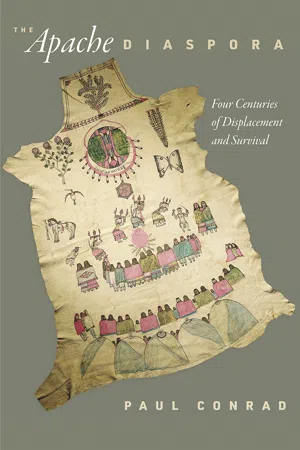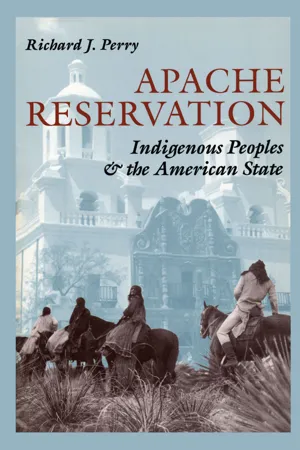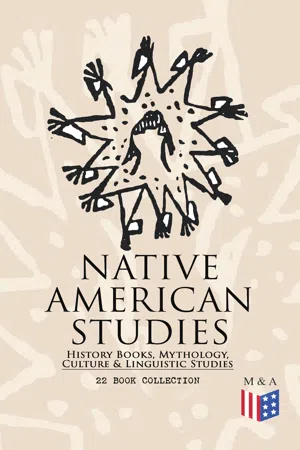History
Apache tribe
The Apache tribe is a Native American group known for their fierce resistance against European colonization in the southwestern United States. They were skilled warriors and hunters, and their nomadic lifestyle allowed them to adapt to various environments. The Apache people have a rich cultural heritage, with traditional practices and beliefs that continue to be celebrated today.
Written by Perlego with AI-assistance
Related key terms
4 Key excerpts on "Apache tribe"
- eBook - ePub
To Live and Die in the West
The American Indian Wars
- Jason Hook, Martin Pegler(Authors)
- 2014(Publication Date)
- Routledge(Publisher)
The Apaches IntroductionThe origin of the name ‘Apache’ is unclear, though it probably stems from the Zuni ‘ápachu’, their name for the Navajo, who the early Spaniards called ‘Apaches de Nabaju’. One suggested alternative is that it originated in the rare Spanish spelling ‘apache’ of ‘mapache’, meaning raccoon, which in view of the distinctive white stripes typically daubed across a warrior’s face is rather attractive, if unlikely. The Apaches in fact referred to themselves with variants of ‘ndé’, simply meaning, in common with many Indian self-designations, ‘the people’.The Apache culture of 1850 was a blend of influences from the peoples of the Great Plains, Great Basin and the South-West, particularly the Pueblos, and—as time progressed—from the Spanish and American settlers. Tribal peculiarities depended upon geographical location in relation to these peoples, and the time and route of a tribe’s early migration. In a work of this size, generalisations concerning ‘typical’ Apache traits of the Chiricahua, Mescalero, Jicarilla, Western and Lipan Apaches—e.g. the eating of mescal, hunting and gathering economy, the puberty rite, masked impersonators of the Mountain Spirit supernaturals—inevitably have to be made. Tribal and indeed individual divergences naturally occurred in what was a highly individualistic society; but where a reference is made to a common trait, it describes a feature considered integral to the rich and distinctive Apachean culture.An 1880s studio shot of Nalté, a San Carlos Apache warrior, labelled the ‘San Carlos dude’. Note the identification tag hanging from his necklace, and the quirt on a thong around his wrist. The Frank Wesson carbine he is holding is a studio prop. (Arizona State Museum, University of Arizona)The Apache tribesThe Apachean or Southern Athapaskan language, and therefore the Apache people themselves, can be divided into seven tribal groups: Navajo, Western, Chiricahua, Mescalero, Jicarilla, Lipan, and Kiowa-Apache. For the purposes of this work, the Navajo - eBook - ePub
The Apache Diaspora
Four Centuries of Displacement and Survival
- Paul Conrad(Author)
- 2021(Publication Date)
- University of Pennsylvania Press(Publisher)
They would come to know that they were anchored to particular places, however. The names of local groups indicated as much: “ni-ki-ya-dé-ne” (people of the land that is their native land) was the name of one Apache local group in the nineteenth century. The names of the networks of local groups that together composed bands also usually referenced the lands in which they lived or the resources they harvested from them, for example: Cúelcahén Ndé, “people of the tall grass.” 16 Only later, if they remained with Apaches for a longer time, would a captive have become familiar with their stories and belief in the creator, Ussen, who had made the universe, and White Painted Woman, mother of Child of the Water, who had then created people. Only later would they come to understand the power of the mountain spirits, or gahe, and ceremonies like the Crown Dance, in which masked dancers invoked the gahe, usually joined by a clown who entertained the crowd but also possessed curative power. Only later would they have come to fully understand the moral code that divided insiders from outsiders, sanctioning the taking of enemy property through raids designed to avoid pursuit and making it imperative to retaliate for loss of kin by mobilizing war parties. 17 If captivity and mobility had played a role in the Apache past, they would play an even more important role in the future, beginning in the sixteenth century, when the Spanish began entering into Apache territories periodically. Although these expeditions failed to establish a permanent Spanish colony, they succeeded in taking a number of captives. The Chamuscado-Rodriguez Expedition of 1581 was not the first such incursion, and it was not atypical when its members seized a captive to serve as a guide from an Apache settlement they encountered on the banks of the Pecos River, in what is now southeastern New Mexico - eBook - ePub
Apache Reservation
Indigenous Peoples & the American State
- Richard J. Perry(Author)
- 2014(Publication Date)
- University of Texas Press(Publisher)
More often, though, many Apache leaders became convinced that the only hope for the physical survival of their people was peaceful submission to reservation life. For years many of them had witnessed the slaughter of their children and relatives. They had seen their numbers depleted and had lost control of their territorial base. Some, such as the Arivaipa leader Eskiminzin and the Chiricahua Loco, decided that to continue resistance would mean the complete destruction of their people. Helping the army to locate the few bands who remained off the reservation was, to them, a matter of helping their people go on living.But the tales of fighting, slaughter, and destruction are manifestations of other processes that acted to shape events. From one perspective we might be tempted to view the process as an inevitable outcome of Apache raiding. When the Apache began depending on the production of other groups, they placed themselves in conflict with the interests of these peoples. This brought about increasing assaults on their own population. One might argue that if the Apache had stuck to hunting, gathering, and gardening within their own territory this might have been avoided.But such a scenario has its flaws. We have only to look at the scores of peaceful, stable Native American populations elsewhere whose territories were overrun long before the Apache lost theirs. Many of those peoples were all but eliminated. The Apache, on the other hand, managed to hold off the concerted assaults of three different states for centuries before they finally succumbed.In 1871 the Arizona Territorial Legislature complained that Apache depredations constituted an obstacle to “immigration and capital” necessary to develop the region. They went on to assert:Probably, but few countries on the face of the globe presents greater natural resources inviting to immigration and capital than the Territory of Arizona. Nearly every mountain is threaded with veins of gold, silver, copper, and lead. Large deposits of coal and salt of an excellent quality are found. Nearly every foot of the Territory is covered with nutritious grasses, and stock thrives the year round without shelter or prepared forage. Nearly every product that grows in the temperate or torrid zone can be grown here to perfection and in abundance. There are vast forests of excellent timber; the mountains and valleys are amply supplied with pure water; the climate is warm, genial, and healthful, equal to any on the American continent. (Arizona Territorial Legislature 1871:3) - eBook - ePub
Native American Studies: History Books, Mythology, Culture & Linguistic Studies (22 Book Collection)
History of the Great Tribes, Military History, Language, Customs & Legends of Cherokee, Iroquois, Sioux, Navajo, Zuñi, Apache, Seminole and Eskimo
- Charles C. Royce, Clay MacCauley, Franz Boas, William John McGee, James Mooney, Garrick Mallery, John Wesley Powell, Lewis Spence, Erminnie A. Smith, James Owen Dorsey, Frank Hamilton Cushing, Cyrus Thomas, John G. Bourke, Elias Johnson, John Heckewelder, William C. Reichel, Joseph Kossuth Dixon, Al(Authors)
- 2018(Publication Date)
- Madison & Adams Press(Publisher)
EDWARD S. CURTIS.A Noonday Halt - NavahoApache CampTypical ApachePassage contains an image
The Apache
Table of ContentsHistorical Sketch
Table of ContentsThe Indian and his history present innumerable problems to the student. Facts seemingly contradict facts, well-founded theories contradict other theories as well founded. Linguistically the Apache belong to the great Athapascan family, which, according to the consensus of opinion, had its origin in the far North, where many tribes of the family still live. Based on the creation legends of the Navaho and on known historical events, the advent of the southern branch of this linguistic group—the Navaho and the Apache tribes—has been fixed in the general region in which they now have their home, at about the time of the discovery of America. Contrary to this conclusion, however, the legend of their genesis gives no hint of an origin in other than their historical habitat. The history and the legendary lore of the Indian are passed down from generation to generation, so that it would seem hardly credible that all trace of this migration from a distant region should have become lost within a period of somewhat more than four hundred years.Again, judging by the similarity in language, the Apache and the Navaho in prehistoric times were as nearly a single group as the present bands of Apache are; and, likewise, there is sufficient similarity in the underlying principles of their mythology to argue a common tribal origin. The names as well as the functions of several of the mythic characters are identical in both tribes, as, for example, the war gods Nayé̆nĕzganĭ and Tobadzĭschí̆nĭ. These miracle-performing twins in each case are the sons of a woman (who occupies an almost identical position in both Navaho and Apache mythology) and the sun and water respectively. Pollen also is deified by each—as Hádĭntĭn Boy among the Apache and Tádĭtĭn Boy among the Navaho. If, therefore, we may concede that the Navaho and the Apache were originally one tribe, as their language certainly indicates, we have many arguments in favor of the theory of long residence in the South-west of this branch of the Athapascan family, for the striking differences in the details of their myths would seem to indicate that the tribal separation was not a recent one, and that the mythology of the two tribes became changed in the course of its natural development along different lines or through accretion of other peoples since the original segregation. The Apache story of their creation portrays human beings in their present form, while in the Navaho genesis myth occurs the remarkable story, unquestionably aboriginal, of the evolution of the lower animals through successive underworlds until the present world is reached, then as spirit people miraculously creating human life.
Index pages curate the most relevant extracts from our library of academic textbooks. They’ve been created using an in-house natural language model (NLM), each adding context and meaning to key research topics.



